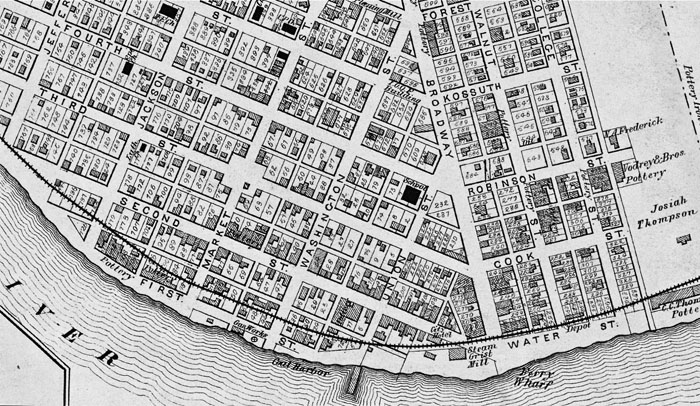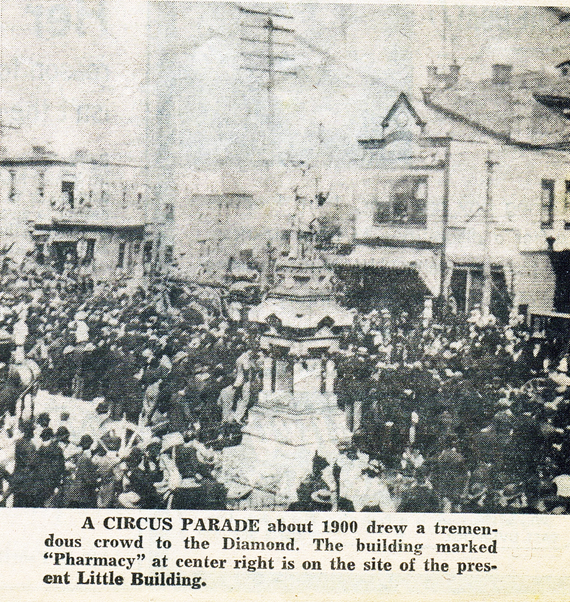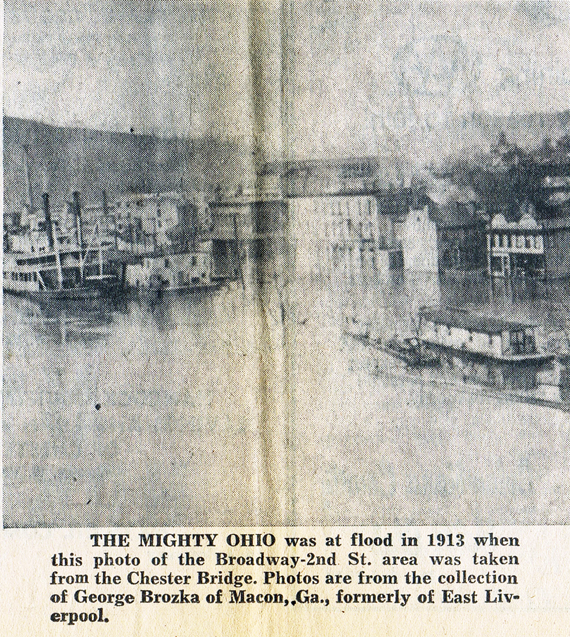
1877 gen2go map. 1877 (7.5 mb) Wellsville, Hamilton, Jethro, East Liverpool. http://gen2go.org/Ohio-River/Wellsville-Hamilton-Jethro-East-Liverpool.pdf
When 2nd Was First
By Robert Popp
East Liverpool Review
Feature Pages
East Liverpool, Ohio Sat. June 21, 1969-page 8
A veritable museum of East Liverpool's past, 2nd Street lies quiet and near-deserted in the hot summer sun, in the last throes of a slow and ugly death that contrasts sharply with a virile promising youth.
Like a grandparent of old left to doze in dream in a chimney corner, the venerable street still can call forth visions of the past when it was the center of all the mercantile activity of the community - and a lot of the revelry and entertainment, too.
Many East Liverpool residents approaching Social Security age recall with fondness the days when 2nd St's pavement's echoed to the clopping of many horses hooves and the clatter of iron wheeled wagons and streetcars threading their way through the business district crowds.
Twenty or more trains wheeled in the depot every 24 hours, discharging swarms of passengers who hurried to nearby restaurants or checked in at the city's leading hostelry - the hotel McKinley. Dozens more boarded the eastbound and westbound trains for business and pleasure trips to places like Pittsburgh and Cleveland.
The city wharf at Broadway, a stone's throw away, was busy, too. Packet boats tied up there frequently to unload passengers or consignments of poultry, livestock and hoop poles.
The railway station in the hotel were two of the busiest spots on a busy street. In addition to the perspective passengers, the depot was crowded with onlookers who never tired of watching the dramatic arrivals and departures of the trains and speculating about the identities, and missions of the strangers who alighted.
Newsboys always had for the depot with the first consignment of papers hot off the press. Newspaper reporters haunted the depot to buttonhole departing dignitaries or greet newcomers in hopes of finding a story. Police checked the depot frequently. Since it was the only quick mode of transportation, the railroad was the agency by which most of the crooks of the era went from town to town.
George H. Brozka of Macon, Ga., Formerly of East Liverpool, who furnished the photos the company this story, remembers 2nd St. when it was passed the height of its glory, but still one of the community's busiest thoroughfares. Born there in 1905, he spent his boyhood in the 2nd St. area and he remembers vividly many of the sites, smells and sounds of the quieter, slow-paced time.
As a child he played around lumber storage yard operated by his father, John Brozka, and watch with fascination the noisy, smoky operation of the blacksmith shop operated by his grandfather, Martin Brozka.
George Brozka was born in the family's home on E. 2nd St. between Union and Washington Sts. he remembers playing along the street the accompaniment of the sound of the horses hooves on the brick pavement and the screeching wheels the trolley cars as they descended Washington St., crept along 2nd St. and then headed east near the River Rd. to the terminus of the line at Mulberry St. and Pennsylvania Avenue.
Some of his most vivid memories are watching the riverboats discharging their clucking, bawling cargoes at the Broadway wharf.
"That was one of the highlights of any day, to watch boats like the General Wood or the Betsy Ann move in to the wharf," he says. "I can smell those chickens and turkeys yet, and here the cattle bawling. And many of the boats from downriver brought big load to the hoop poles that were used in making casks for the potteries."
The late Hugh J. McDermott, who joined the police force in 1902, remembered walking the 2nd St. beat as a young patrolman. 45 years later, when he was preparing to retire as chief, he recalled some of the saloon brawls and murders that made the business district garish, dangerous place after dark.
And walking the beat young patrolman was a fledgling police reporter, late of Gallipolis, who was working the old Morning Tribune. He was O. O. McIntyre, who went on to New York City to become an author of one of the most widely-read syndicated columns of his day-" New York Day by Day." McIntyre sometimes referred to McDermott and East Liverpool in his column. And he frequently cited the superior quality of the bean soup he had consumed and railroad terminal restaurants in East Liverpool and Gallipolis.
One of McDermott's favorite antidotes concern the tremendous saloon brawl that he happened onto late one night while walking his beat with McIntyre.
The burly young Irishman, known throughout the region as a tremendous battler, marched into the saloon alone to quell the brawl. McIntyre stood on a pile of railroad ties outside and watch through a window at a safe distance he remembered.
Some of the buildings have been altered to a greater or lesser degree and some have disappeared because of fire or the wreckers hammer, but many that forage in that era of the turn of the century still a recognizable.
The old-timers recall Dave Devine's Restaurant, which advertised meals for 25 cents, and Schleiter's furniture store and Rayl's meat market, almost directly across the street from the restaurant.

Many of the political and social intrigues of the day were threshed out underneath the marquee at the hotel McKinley or in its plush lobby. Most travelers of note who stopped overnight here were guests at the McKinley. The old hostelry degenerated down through the years, finishing its days under the name Hotel DeSylvan as a rooming house. After it finally closed, it was sold by the federal government to satisfy a tax lien and it since has been converted to commercial use.
Brozka remembers in his boyhood that the McKinley had a grand, plush lobby, but he can't recall many of the details. He recalls it was "the best hotel in town" at the time. The late Frank R. O'Hanlon recalled interviewing of visiting senator in the hotel in the era before World War I when he was a cub reporter. And- half-century later and shortly before his death- he remembered the senator cutting off the interview abruptly because he thought one of reporter's questions was impertinent.
The late Patrick J. O'Farrell who was secretary of the Chamber of Commerce, recalled hustling to the 2nd St. depot with a push cart loaded with newspapers, hot off the presses of the Morning Tribune, and the brisk business that awaited him among the travelers. Ender series as well as retail businesses flourished along 2nd St. and in the riverfront district.
In 1905, the year Brozka was born, John Scleiter's furniture store was flourishing at 128 2nd St. and Dave Devine ran an advertisement each day in the evening review: coming or going, stop at Devine's Restaurant, West side of C&P Depot 139-111 2nd St. D. A. Devine proprietor.
Brozka remembers the Bagley Co., which dealt in wholesale groceries and confectioners' supplies. It was at 151 – 153 E. 2nd St. The Bagley Co. imprint appears on a postcard view of flourishing second St.
But Ms. us men were active, also in the stretch of fifth St., near Market St., and on the diamond.
In February 1905, Frank Crook bought a lot on fifth St. from William Erlanger and announced he intended to erect a five-story brick business building that probably would cost $47,000. It was termed by the newspaper "the biggest real estate deal of the year." Crook's store then was at fifth and market streets.
The side of his newly acquired-property faced on what was called Mulberry alley, now known as crook alley. He said it would be necessary to tear down the building occupying the tract, housing the Delmonico Club.
In addition to the business places on 2nd St., others were nearby on Broadway and market Sts. Joseph Brothers Clothing Store was at 223 – 226 Market St. and James M. McDole was operating a wallpaper store at 265 Broadway. E. W. and Arthur D. Hill acquired the former home of the Daily Crisis – a building at Broadway and 3rd St. – and announced they would converted into a warehouse.
W. Smith Fowler was asking Council to widen a sidewalk by at least three feet, remove the Civil War monument and the pump in the center and put down new brick paving. He said the streetcar companies should erect a waiting room in the diamond. He was described as the owner of a big tract of property on the West side of the diamond.

A huge ice gorge that it tied up river traffic for more than two weeks let go with the tremendous war on the morning of February 11, 1905, attracting hundreds to the shore. The newspaper related that many boats were damaged in the ensuing runoff. The next day, fire destroyed a shanty boat at the foot of Union St. and the indigent woman occupant and her 5 children applied for aid at City Hall.
C. A. Smith announced his new home overlooking Rock Springs Park in Chester would be completed by spring. Pleasant Heights residents were preparing to petition the Board of Education to build a new school and the growing residential area. They said the structure was meant to house 50 pupils and more than 60 were enrolled.
A Common Pleas Court jury in Lisbon found the Civil War veteran not guilty of stealing a horse and buggy in East Liverpool. John Reark, Edward O'Neill and Patrick Lynch were arranging a benefit dance for the New City Hospital.
And along 2nd St., unaware of the long decline it still in the future, life went on as it had from the early days of the city's history. There was the Potter's Supply Co. at the foot of Washington St. And S.C. Williams of the S. C. Williams Co. operated a gas well between Jackson and East alley, using the field of power sawmill and other equipment at his plant. The same gas well supplied fuel to large homes along 5th St., where the merchant tile district had not yet begun to encroach.
Brozka has many other photos guaranteed to stir nostalgia in old-timers' hearts. Most of the pictures were taken by his father in the period between 1890 in the early 1900's. The elder Brozka recalled he developed and printed his own pictures because commercial photographers felt the amateurs were "trying to cut into their business."
The collection also includes many photographs of East Liverpool's early streetcars, Chester, Rocks Springs Park and other spots associated with traction company operations.

The elder Brozka, an employee of the first streetcar company, help assemble the first of the electric cars when it was shipped here by railway flat car from the factory. Two of his sons, including George, also worked for the streetcar company later.
George Brozka is married to the former Betty Faulk, a daughter of the late George Faulk, who was secretary-treasurer of Steubenville, East Liverpool and beaver Valley Traction Co. and its successor, the Valley Motor Transit Co. He has resided in Macon for 10 years and is employed as a science department storekeeper at Mercer University in Macon.
Brozka city intends to donate many of the historical photos, along with the data find date, to the East Liverpool historical Society Museum.
[there are a couple more Brozka's photos that appeared in Bob Popp's article that aren't included here but are used and will be identified in the 2nd Street articles that are included here as part of this project. -- Webmaster]
An additional article on 2nd Street by the late Glenn H. Waight:
This site is the property of the East Liverpool Historical Society.
Regular linking, i.e. providing the URL of the East Liverpool Historical Society web site for viewers to click on and be taken to the East Liverpool Historical Society entry portal or to any specific article on the website is legally permitted.
Hyperlinking, or as it is also called framing, without permission is not permitted.
Legally speaking framing is still in a murky area of the law
though there have been court cases in which framing has been seen as violation of copyright law. Many cases that were taken to court ended up settling out-of-court with the one doing the framing agreeing to cease framing and to just use a regular link to the other site.
The East Liverpool Historical Society pays fees to keep their site online. A person framing the Society site is effectively presenting the entire East Liverpool Historical Society web site as his own site and doing it at no cost to himself, i.e. stealing the site.
The East Liverpool Historical Society reserves the right to charge such an individual a fee for the use of the Society’s material.